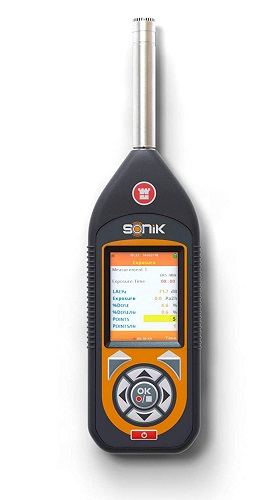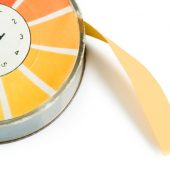A sound level meter, also called a decibel meter, measures sound level in an environment. This can be ambient (background) sound or sound from a specific source.
There are numerous situations and environments where determining sound level (and adjusting it) is essential for comfort, safety and productivity.
Some obvious places include factories, offices, workshops and music studios. You can also use a sound level meter at home to check ambient sound levels from the road, appliances and other sources.
What to Consider When Choosing A Sound Level Meter
The best sound level meter depends on the kind of noise you want to measure, the measuring environment and the required level of accuracy.
Here’s what to consider when shopping for a decibel meter.
a) Class
BS EN 61672-1:2013 defines two classes of acoustic meters: class 1 and class 2.
These classes refer to the performance and accuracy of the sound level meter.
- Class 1 meters are referred to as precision-grade meters. They offer the best level of accuracy and can measure sound over a wider frequency range.
- Class 2 meters are general-grade meters. They are less precise and have a narrower frequency range.
Class 1 sound level meters are ideal in environments where accuracy and precision are essential such as in a laboratory, studio and building acoustics.
If you are taking sound measurements that will be submitted as part of legal proceedings, you’ll also need a class 1 sound level meter.
Class 2 meters are ideal for situations where high-level precision is not necessary such as offices, at home and measuring environmental noise.
- Read also: How To Choose The Best TDS Meter?
b) Type of Meter
There are two general types of sound level meters.
- Integrating sound level meters: These measure sound over time to provide an equivalent continuous sound level. Because continuous sound level is the most useful when accessing risk of hearing damage, most standards and safety requirements mandate integrating sound level meters.
- Non-integrating sound level meters: These measure sound at a specific moment. They are only ideal for quick sound level checks or to measure a steady noise level.
c) Frequency Weighting
Frequency weighting refers to the way a sound meter adjusts how it measures sound levels to more accurately represent what humans hear.
There are three types of frequency weightings: A, C and Z.
A weighting is the most common and is available in all sound level meters. Most workplace safety standards require sound measurements be taken based on A frequency weighting.
- A weighting focuses on mid-range frequencies, which most human-audible sounds fall within. Sound measurements taken with A weighting are noted as dBA.
- C weighting focuses on low and high frequencies. It’s often used in entertainment venues to measure very loud sounds (over 100 dB). It is also useful in measuring loud temporary noises such as bangs and crashes.
Sounds measured with C weighting are noted as dBC.
- Z weighting is less common. It measures sound as it is actually produced with no frequency weighting applied.
Sounds measured with Z weighting are noted as dBZ.
A and C frequency weighting are the most useful. Thus, many sound level meters combine these two types, letting you select the type of weighting to use at a particular moment.
Some meters measure sound using two or three types of weightings and then display measurements for each.
d) Time Weighting
There are three types of time weightings: fast, slow and impulse.
These time weightings were common in analogue sound level meters. They determined how quickly the needle moved.
Modern digital sound level meters typically offers just fast and slow time weightings.
- Fast weighting speeds up measurements to an interval of 125 milliseconds. It is ideal when measuring quickly varying sound levels. It gives you a better idea of the noise range.
- Slow weighting slows down measurements to 1-second intervals, which smooths out measurements and gives you an average reading.
e) Measuring Range
The measuring range of a sound level meter tells you what kind of noise you can measure. If the sound you plan to measure is in the extremes (too quiet or very loud), you’ll need a decibel meter with a wide range.
The standard range for sound level meters is 30-130 decibels. Some decibel meters can measure sound as quiet as 22 decibels and as loud as 143 decibels.
f) Accuracy and Resolution
The standard accuracy for most sound level meters is ±1.4 or ±1.5 dB. This margin of error is small enough to achieve the precision required for most acoustic-measuring applications.
Also check the resolution of the sound level meter. Resolution is the smallest decibel measurement a sound level meter can measure. High resolution results in better measuring precision and accuracy.
The standard resolution for professional sound level meters is 0.1 dB.
g) Display
As with any measurement tool, the display is an important aspect of the meter. It should be large and easy to use in any kind of lighting (meaning it should be backlit).
Also check what the display shows. All displays will show the sound level measured. Some also include a bar graph, the current time, battery level and low battery indicator.
- Read also: How To Choose The Best pH Meter In The UK?
h) Data Logger
Do you want access to previous recordings? If you do, look for a sound level meter with internal memory that logs readings.
Most sound level meters with internal memory can log several thousand readings.
Best Sound Level Meters: Reviews
1. VLIKE LCD Digital Decibel Meter Review

The VLIKE can be used in a wide variety of environments including offices, factories and outdoors. It’s also great for residential acoustic measurements.
It has both dBA and dBC modes – just press a button to switch from one to the other depending on the frequency of the sound you are measuring.
You can also select the type of time weighting you want: fast or slow.
The measurement range is 30 to 130 dBA and the frequency response range is 30Hz – 8KHz.
As you take measurements, the large display shows the decibel readings as well as a bar graph to enhance analysis. The display is backlit, so you can measure sound levels even at night or in a dark room.
Other features and functions include HOLD for freezing the latest reading on the display (you can walk away from the measuring area to record the reading), MAX for holding the highest reading measured and a backlight button to turn the display light on or off.
The VLIKE decibel meter is compact with a contoured design that easily fits into your hand. Grips on either side of the meter ensure the unit does not slip from your hand.
2. PeakTech 8005 Sound Level Meter Review

If you are looking for a sound level meter with internal memory, we recommend the PeakTech 8005. It can store up to 32,000 data points for future reference.
The PeakTech 8005 measures sounds between 30 to 130 decibels with a 0.1 dB resolution.
Depending on your measuring needs, you can choose a specific time and frequency weighting. For time, options are fast and slow. For frequency, options are A and C.
The LCD display is backlit for easy viewing in any lighting. It shows the current reading as well as a bar graph and time.
There’s a max/min button to show the highest and lowest measurements and a HOLD button to freeze the last reading on the display.
PeakTech 8005 is a class 2 sound level meter, so it’s more ideal for general environments such as offices, the outdoors and homes.
If you need to take readings for an extended period, there are two features that’ll help: a USB interface cable and a tripod.
The tripod has the additional advantage of ensuring stable measurements without interference from you hand movements.
The PeakTech 8005 has analogue AC/DC outputs just in case you need to connect it to a frequency analyzer.
3. Meterk Sound Level Meter Review
If you are looking for a cheap sound level meter for basic sound measurements, we recommend the Meterk Sound Level Meter.
It doesn’t have as many features as pricier models, but it’s perfect for measuring sound levels at home or checking how loud your neighbors are.
The Meterk decibel meter offers only A weighting, which is adequate for residential measurements. It does not have any time weighting options.
The only functions on the control panel are HOLD and MIN/MAX.
There’s also a button to light up the large display on which you can see the current reading and an OVER warning if measurements are higher than the pre-set range.
The display also shows the current battery level and will alert you if it gets too low.
The Meterk sound level meter comes pre-calibrated.
4. SONIK-SE Sound Level Meter Review
The SONIK-SE is the most expensive sound level meter among our picks. That’s because it is designed for high-precision measurements. It is the best decibel meter for professionals.
SONIK-SE is a class 1 sound level meter, making it ideal for lab, environmental and workplace sound measurements.
The large screen gives you access to numerous measurement parameters including peak, Lmax, Leq and others.
The SONIK-SE has tons of useful features for pros. Here is a summary of the best ones.
- Recording: You can take a real-time recording of measurements. The meter will store recordings for future reference.
- PC data transfer: You can transfer measurements to your PC and analyse them using the free Windows software.
- Templates: In the SONIK-SE menu, you can select between an Environmental or Noise at Work template. Each template changes how the meter records sound.
- Full range of time and frequency weightings: Frequency weighting options are A, C and Z while time weighting options are fast, slow and impulse.
- Wide measuring range: Being a Class 1 sound level meter, the SONIK-SE offers a wider range than most decibel meters. It can measure between 25 dB and 140 dB.
Other menu features include brightness adjustment, screen colour and calibration.
There are many more features in the SONIK-SE that will take you some time to go through. Fortunately, it comes with a highly detailed manual explaining everything clearly.
5. TROTEC SL300 Sound Level Meter Review

The TROTEC SL300 is another good choice if you are looking for an affordable sound level meter. Being a class 2 meter, it is ideal for lower-precision measurements at home, at the office or near a road.
The TROTEC SL300 has a measurement range of 30 – 130 dB with an accuracy of ±1.4 dB.
It has all the basic functions of a sound level meter including HOLD, MIN and MAX. You can also select between A and C frequency weighting and fast or slow time weighting.
The display is big enough and backlit for easy viewing. In addition to the sound level value, the screen also shows a bar graph.
The TROTEC SL300 is designed for easy one-handed operation. It fits easily in one hand and you can reach all buttons with your thumb.
Accessories provided include a wind break and a battery.



